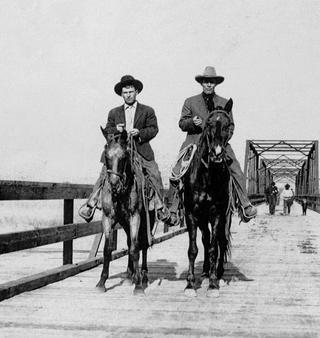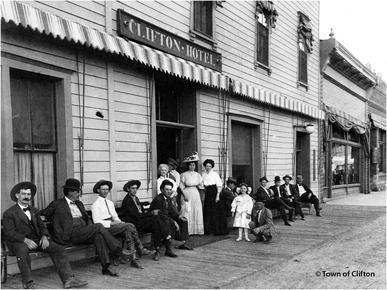Wild West Legends. Mountain men, like James Pattie, ventured up our rivers and creeks in 1825. They were looking for “soft gold” in the form of beaver pelts.
Geronimo, born in 1829 “where the three rivers meet” tells his own tales of the county. Insisting he was born in Arizona, not New Mexico, has led historians to believe Clifton or the nearby area is his birthplace. The close proximity of the confluence of Eagle Creek and the San Francisco River with the Gila River, known today as the Gila Box Riparian Area, meets his description. It is also said that Geronimo asked his captives to allow him to live out the remainder of his days in Arizona, off the reservation, on Eagle Creek (believed to be referencing the Lower Eagle Creek area near Clifton). In 1879, a warrior named Victorio left the San Carlos Apache Reservation and raided Clifton. Geronimo’s band did likewise in 1882 and killed eleven Mexican teamsters twelve miles to the south.

Ranches & Outlaws. Ranching began in this area in the mid-1800’s, bringing large groups of pioneer settlers. However, where there are cattle and new settlements, there are cattle rustlers, renegades and outlaws ready to terrorize the area. Names like Black Jack Christian, Augustin Chacon (tried in 1896 for his Morenci robberies and murders), Red Sample, Tex Howard, Nicolaus Olquin, Rufus Nephew and gangs like the “Wild Bunch” roamed this region. While Butch Cassidy and the Sundance Kid worked as trail-hands, fellow gang members Harvey “Kid Curry” Logan and another unidentified man absconded with $12,000 of the Clifton Bank’s money in 1898. When the outlaws were in need of provision, they counted on some local ranches, or legendary allies like Charlie Moore. The Outlaw Trail, running its course through this county, offered many hideouts and ranch hand opportunities for the outlaws.

Renegades disguised as traveling cowhands looking for their next pay day was a common occurrence. Although outlaws working the area’s ranches would be on their best behavior in Alma (NM) to the east, Clifton saw many an outlaw running amuck. Clifton’s Chase Creek Street, in particular, was bustling with entertainment and thievery galore. Clifton quickly became the second-most dangerous town in Arizona, only surpassed by the reputation of Tombstone. At its worst locals began to call it “Hell Town”.